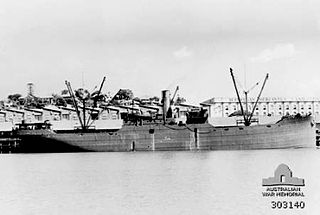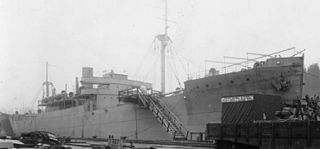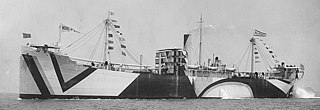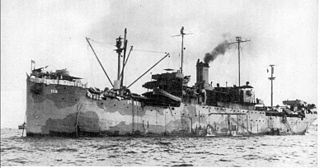The Western Pipe and Steel Company (WPS) was an American manufacturing company that is best remembered today for its construction of ships for the Maritime Commission in World War II. It also built ships for the U.S. Shipping Board in World War I and took part in the construction of the giant Grand Coulee Dam project in the 1930s.
USS Majaba (AG-43/IX-102) was the Design 1049 cargo ship Meriden built in 1919 by the Albina Engine & Machine Works, Portland, Oregon. All the ships were requisitioned by the United States Shipping Board (USSB) for World War I service. The ship was bought by the E. K. Wood Lumber Co., of San Francisco, California in 1923 and renamed El Capitan. The ship was chartered by the U.S. Navy through the War Shipping Administration (WSA) in April 1942 and commissioned as Majaba.

USS West Avenal (ID-3871) was a cargo ship in the United States Navy during World War I. She had been built as SS West Avenal for the United States Shipping Board (USSB) as part of the West boats, a series of steel-hulled cargo ships built on the West Coast of the United States. West Avenal was launched in October 1918 by the Western Pipe and Steel Company of San Francisco, California, and delivered to the US Navy when she was completed in February 1919. After she was commissioned and had taken on a load of flour, West Avenal sailed to Norfolk, Virginia, where she was decommissioned in early April.

The SS Monte Carlo was a concrete ship launched in 1921 as the oil tanker SS Old North State. She was later renamed McKittrick. In 1932 she became a gambling and prostitution ship operating in international waters off the coast of Long Beach, California, United States, and was relocated to Coronado, California in 1936. The Monte Carlo was grounded on Coronado Island on New Year's Day 1937 during a storm and her wreck remains on the beach.

The Design 1013 ship, also known as the Robert Dollar type, was a steel-hulled cargo ship design approved for mass production by the United States Shipping Board's Emergency Fleet Corporation (EFT) in World War I. Like many of the early designs approved by the EFT, the Design 1013 did not originate with the EFT itself but was based on an existing cargo ship design, in this case one developed by the Skinner & Eddy Corporation of Seattle, Washington.

The Design 1023 ship was a steel-hulled cargo ship design approved for mass production by the United States Shipping Board's (USSB) Emergency Fleet Corporation (EFC) in World War I. Like many of the early designs approved by the EFC, the Design 1023 did not originate with the EFC itself but was based on an existing cargo ship designed by Theodore E. Ferris for the United States Shipping Board (USSB). The ships, to be built by the Submarine Boat Corporation of Newark, New Jersey, were the first to be constructed under a standardized production system worked out by Ferris and approved by the USSB.
The Design 1017 ship was a steel-hulled cargo ship design approved for production by the United States Shipping Board's Emergency Fleet Corporation (EFT) in World War I. They were referred to as the "Downey-type" as they were built by Downey Shipbuilding on Staten Island. 10 ships were completed for the USSB in late 1918 and through 1919. An additional ship was completed in 1920 for a private shipping company.
The Design 1018 ship was a steel-hulled cargo ship design approved for production by the United States Shipping Board's Emergency Fleet Corporation (EFT) in World War I. They were referred to as the "Sun-type" as they were built by Sun Shipbuilding & Drydock Co. in Chester, Pennsylvania. 4 ships were completed for the USSB in late 1919 and through 1920. An additional ship was completed in 1920 for a private shipping company.
The Design 1020 ship was a steel-hulled cargo ship design approved for mass production by the United States Shipping Board's Emergency Fleet Corporation (EFT) in World War I.
The Design 1021 ship was a steel-hulled cargo ship design approved for production by the United States Shipping Board's Emergency Fleet Corporation (EFT) in World War I. They were referred to as the "Long Beach-type" as they were built by Long Beach Shipbuilding Company in Long Beach, California. Three ships were completed for the USSB in 1918 and 1919.

The Design 1014 ship was a steel-hulled cargo ship design approved for production by the United States Shipping Board's Emergency Fleet Corporation (EFT) in World War I. They were referred to as the "Cascade"-type. They were all built by Todd Shipyards, then part of Todd Drydock and Construction Company, at their Tacoma, Washington shipyard. 20 ships were completed for the USSB in 1919 and 1920; and additional 2 were completed in 1920 for private companies. 12 ships were cancelled.

The Design 1015 ship was a steel-hulled cargo ship design approved for production by the United States Shipping Board's Emergency Fleet Corporation (EFT) during World War I. They were referred to as the "Moore & Scott"-type.

The Design 1025 ship was a steel-hulled cargo ship design approved for production by the United States Shipping Board's Emergency Fleet Corporation (EFT) in World War I. They were referred to as the "Harriman-type" as the majority of ships were built in the Harriman section of Bristol, Pennsylvania. A total of 62 ships were ordered and built at three shipyards: 40 ships at Merchant Shipbuilding Corporation, Bristol, Pennsylvania; 12 ships at Newburgh Shipyards in Newburgh, New York; and 10 ships at Pensacola Shipbuilding Company in Pensacola, Florida.

The Design 1027 ship was a steel-hulled cargo ship design approved for production by the United States Shipping Board's Emergency Fleet Corporation (EFT) in World War I. They were referred to as the Oscar Daniels-type as all the ships were built at the Oscar Daniels Shipbuilding Company, Tampa, Florida. A total of 10 ships were ordered and built from 1919–1921.

The Design 1029 ship was a steel-hulled passenger/cargo ship designed to be converted in times of war to a troopship. design approved for production by the United States Shipping Board's Emergency Fleet Corporation (EFT) in World War I. They were referred to as the 535-type as all the ships were 535 feet overall length. A total of 10 ships were ordered and built from 1921 to 1922. An additional six ships, originally contracted as Design 1095 ships, were changed during building so they were identical to the Design 1029 ships. Three shipyards built the ships: Bethlehem Sparrows Point Shipyard of Baltimore, Maryland ; Newport News Shipbuilding & Drydock Company of Newport News, Virginia ; and New York Shipbuilding Company of Camden, New Jersey.
The Design 1031 ship was a steel-hulled tanker ship design approved for production by the United States Shipping Board's Emergency Fleet Corporation (EFT) in World War I. A total of 16 ships were ordered; 5 were cancelled and 11 were built from 1919 to 1920. Two shipyards were used in their construction: Bethlehem Wilmington Shipyard of Wilmington, Delaware ; and Terry Shipbuilding Company of Savannah, Georgia.
The Design 1032 ship was a steel-hulled tanker ship design approved for production by the United States Shipping Board's Emergency Fleet Corporation (EFT) in World War I. A total of 5 ships were ordered and completed from 1919 to 1920. All ships were constructed by Bethlehem San Francisco Shipyard of San Francisco, California.
The Design 1037 ship was a steel-hulled tanker ship design approved for production by the United States Shipping Board's Emergency Fleet Corporation (EFT) in World War I. A total of 48 ships were ordered and completed from 1918 to 1920. The ships were constructed at three yards: Doullut & Williams Shipbuilding Company of New Orleans, Louisiana, Federal Shipbuilding Company of Kearney, New Jersey, and George A. Fuller & Company of Wilmington, North Carolina.
The Design 1038 ship was a steel-hulled tanker ship design approved for production by the United States Shipping Board's Emergency Fleet Corporation (EFT) in World War I. A total of 16 ships were ordered of which 8 were cancelled and 8 completed from 1919 to 1920. The ships were constructed at the Mobile, Alabama shipyard of the Mobile Shipbuilding Company.
The Design 1041 ship was a steel-hulled tanker ship design approved for production by the United States Shipping Board's Emergency Fleet Corporation (EFT) in World War I. A total of 13 ships were ordered and completed for the USSB from 1919 to 1920. The ships were constructed at the Oakland, California shipyard of Moore Shipbuilding Company. An additional 5 ships were completed separately by the shipyard.









